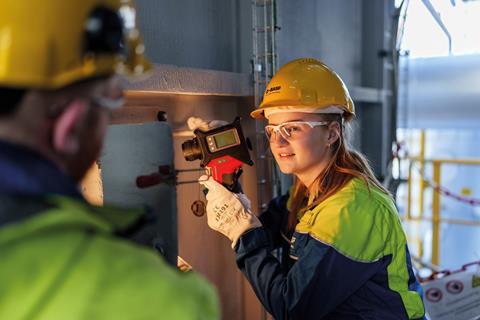Steam cracking, the thermal process used by the chemical industry to transform hydrocarbons into useful smaller molecules such as ethylene and propylene, is very energy-intensive. The amount of energy required varies according to the feedstock and plant design, but is typically more than 30GJ per ton of ethylene produced. Burning natural gas to provide this energy also creates 1.5–2 tons of CO2 emissions per ton of ethylene, meaning greenhouse gas targets will be difficult to achieve with existing cracker designs.

There has been a lot of interest in using electrically powered furnaces to achieve the 850°C temperatures required. This would also avoid energy losses from hot flue gases that make the process inefficient, even if much of the heat is recovered.
A demonstration plant for electric cracking is now running at BASF’s giant complex in Ludwigshafen, Germany, with the hope of proving its feasibility. If that electricity came from renewable sources rather than burning gas, the overall CO2 emissions burden could be cut by as much as 90%, BASF said.
The plant is a collaboration between BASF, Sabic and Linde, and backed by a grant from the German government. Chemistry World reported that BASF was working on the idea back in 2019, when the company said it hoped the demonstrator would be on stream before 2025. Linde now plans to commercialise the technology from the end of 2024, under the brand name Starbridge.
The plant has two furnaces with different designs running in parallel. One uses direct heating, with an electric current applied to the process tubes inside the reactor. Resistive heating inside the tube wall, caused by the electrical resistivity of the material, provides the required thermal energy for the chemical reaction.
We expect that both heating concepts have their own advantages
The second uses electricity to power resistive heating elements around the cracker coils, followed by radiative heat transfer from the heating elements and the insulated walls placed around the tubes. This gives indirect heating. Together, the two furnaces can process about 4 tons of hydrocarbon feedstock an hour, using 6MW of electrical power.
‘We want to test and demonstrate the reliability of key components, like materials of construction and custom-made components, for use in this type of high-temperature reactor,’ says Michael Reitz, steam cracker/eFurnace technology manager at BASF. ‘We expect that both heating concepts have their own advantages.’
The main environmental advantage is the reduction in direct carbon emissions compared to a fossil-fired furnace, Reitz says. The only heat losses from the eFurnace are to the insulation, he says, with none of the additional flue gas losses that occur in a conventional furnace. This makes the furnace boxes more efficient, lowering their overall energy demand as well as running on cleaner energy sources.
Electricity is the most reasonable alternative to reduce CO2 emissions
The next step is to construct industrial-scale furnaces, he says, although timelines also depend on securing supplies of renewable energy at competitive prices. BASF already meets 20% of its global electricity demand with wind and solar energy, and Reitz says this should rise to at least 60% by 2030, both by making its own and buying in more. The company recently agreed to buy a 49% stake in Vattenfall’s Nordlicht wind farm project in the German North Sea, adding to existing wind farm investments in the Netherlands and China.
Reitz says that developing new technologies is always risky, and the consortium with Sabic and Linde has been important to its success. ‘It would not have been possible to complete the project so quickly and in such a target-oriented way without the contribution of the various resources and competencies,’ he says. ‘We are optimistic. The use of electricity is the most reasonable alternative among the potential measures to reduce CO2 emissions.’